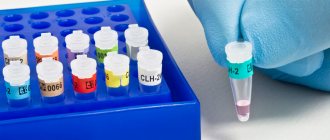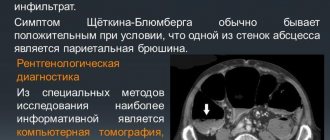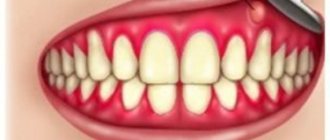Diagnosing and solving problems that lie on the border of two or three medical specialties requires the most time and effort. One of these pathologies is odontogenic sinusitis, which is treated by an otolaryngologist and dentist.
Odontogenic (from the Greek odus, genus odontos - tooth, genesis - origin, development) maxillary sinusitis or sinusitis is a chronic inflammation of the mucous membrane of the maxillary sinus, provoked by pathology of the teeth of the upper jaw, namely periodontitis, tooth extraction with the formation of communication between the oral cavity and sinus, or the entry of plastic material into the sinus when filling the canals of the teeth. The share of this disease in the structure of all maxillary sinusitis ranges from 10 to 40%, and up to 75% of all unilateral sinusitis.
Reasons for the development of pathology
The formation of an acute purulent process in the subcutaneous fat layer near the lymph nodes can be triggered by a significant decrease in immunity. If there is inflammation of the lymph node itself, then a delay in lymph outflow and increased vascular permeability are observed.
Adenophlegmons develop due to ongoing inflammatory processes of any localization. Often this pathology is diagnosed against the background of malignant tumors, some types of dermatitis, chronic dental pathologies, and inflammation of the tonsils.
Diagnostics is aimed not only at identifying adenophlegmon, but also at establishing the cause of its occurrence - medical tactics for this pathology depend on this.
How does maxillary sinusitis manifest?
When visiting an ENT doctor, patients usually complain of heaviness, sometimes pain or swelling of the soft tissues in the area of one maxillary sinus, prolonged runny nose, hyposmia (decreased sense of smell) or, conversely, a constant unpleasant odor in the nose. Often such patients report frequent and painful sinusitis, multiple punctures, numerous courses of antibiotics, which brought only a temporary improvement in their condition or did not help at all. And only with a detailed collection of the medical history is it possible to find out about the recent or long-standing treatment of the “causal” teeth by the dentist, namely “7s”, “6s” or “8s” of the upper jaw of the corresponding side. But it happens the other way around: the patient does not make any complaints, but when preparing for dental prosthetics or sinus lifting, the dentist identifies pathology of the maxillary sinus on a computer tomogram and refers it to an ENT specialist. The reason for such careful preparation and alertness of our colleagues is the golden rule of planned surgery - the absence of inflammatory changes in the surgical area, because otherwise there is a high risk of implant rejection, scarring and a generally worse outcome of the operation.
Symptoms of adenophlegmon of different types
Symptoms depend on where adenophlegmon developed:
- With submandibular adenophlegmon, body temperature rises, swallowing may be difficult, problems with speech arise, swelling forms in the affected area, redness of the skin and pain when palpated are observed.
- With adenophlegmon of the neck, symptoms appear only when there is a critical accumulation of coccal microflora in the tissues of the anterior or lateral part of the neck. There is an increase in body temperature, pain when feeling the neck, redness of the skin, but swelling may be absent.
- With inguinal adenophlegmon, the clinic develops against the background of an inflammatory process in the genitourinary system. This type of adenophlegmon is characterized by rapid progression, while the patient experiences severe pain, due to which he cannot move freely. There are also signs of general intoxication of the body.
- With adenophlegmon of the axillary region, symptoms more often occur with open wounds of the upper extremities. Signs are pronounced: enlargement of regional lymph nodes, deterioration of general condition (including increased body temperature).
The symptoms for different types of pathology in question are similar, the differences lie only in the location of the lesion. If adenophlegmon occurs in children, then loss of appetite, increased drowsiness, lethargy, and lack of interest in games and others will be noted.
Symptoms of oral phlegmon
- General intoxication, weakness, high temperature, fever, chills;
- The tongue and lower jaw swell and become inactive;
- The tongue becomes so swollen that it may fall out of the mouth;
- Edema and swelling lead to distortion of facial shape;
- Pain at the base of the tongue, neck, painful sensations when chewing and swallowing;
- Gray-brown coating on the tongue;
- Unpleasant putrid odor from the mouth;
- Profuse salivation.
Cellulitis of the jaw develops very quickly, spreading from the affected sublingual space to neighboring areas, the floor of the mouth, and gums. With phlegmon of the lower jaw, inflammation can affect the postmaxillary and peripharyngeal space, chin, and neck.
With dental phlegmon, the symptoms are local in nature and appear against the background of untreated caries. The disease goes through several stages:
- Inflammation of dental tissue, pulpitis and periodontitis;
- Inflammation of the periosteum, swelling of the gums;
- Formation of a purulent sac on the gum.
The purulent formation grows, causes intoxication, chills, and is accompanied by bad breath. If dental phlegmon is not diagnosed in time and treatment is not started, there is a risk that the disease will spread to the entire oral cavity.
Treatment of anderophlegmon
The solution to the problem is to carry out complex treatment:
- The purulent focus is opened under local anesthesia or general anesthesia;
- it is being sanitized;
- install drainage without suturing the wound;
- apply a sterile bandage with a mandatory change once a day.
When treating adenophlegmon, antibiotics are used - not only in the form of tablets or injections, but also topically, to wash the abscess cavity. If you seek qualified medical help in a timely manner, the prognosis is favorable. But we must not forget that there is a high risk of developing sepsis.
Information about in what cases adenophlegmon of the floor of the mouth develops and what features of treatment of the disease you need to know is contained on our website https://www.dobrobut.com/.
Prevention of cellulitis and oral infections
The best way to avoid oral phlegmon is prevention.
- Regular visits to the dentist for professional teeth cleaning, plaque and tartar removal reduces the likelihood of caries and gum problems. Tartar causes bleeding gums, and microtraumas on the gums provide an entry point for bacteria and oral infections.
- General strengthening of the immune system, taking vitamins, and a varied diet with plenty of protein and fiber leave little chance for infections to enter the body through the oral cavity.
How to deal with the disease
After the diagnosis has been confirmed, the patient is sent to the hospital. Treatment of APO includes several successive stages:
- Surgical intervention. It is performed under local (adults) or general (children) anesthesia. In a situation where a tooth has become the source of infection, it is subject to extraction or depulpation (the dental canal is cleaned and a filling is placed). If necessary, an incision is made on the skin and the pus is released from the capsule - often such manipulations are not required, the contents come out on their own under internal pressure. As such, additional cleaning of the affected area is not carried out; the postoperative area is covered with a protective bandage (it is changed daily).
- Drug therapy involves taking anti-inflammatory, antibacterial, and restorative drugs.
- The wound is treated with local antiseptic solutions.
Treatment of APO is exclusively surgical - removal of pus from the capsule followed by the use of local antiseptics and systemic anti-inflammatory and antibacterial drugs. At home, in addition to traditional treatment, you can use several proven effective recipes. First of all, the action of the following compositions is aimed at strengthening the body's defenses and improving the general well-being of the patient.
Take 100 g of dry St. John's wort and 50 g of propolis, pour in 300 ml of vodka (medicinal alcohol). The mixture is poured into a glass container and sealed tightly. The medicine is infused for 7 days in a cool, dark place, filtered. When ready, the tincture is used for rinsing the mouth (the procedure is carried out at least 6 times a month, proportions - 20 g / 100 ml of warm water) and therapeutic compresses.
Compilation of anamnesis, analysis of complaints, visual examination of the patient and assessment of the results of clinical studies are components of the diagnosis of adenophlegmon
A few tablespoons of crushed dry eucalyptus leaves are poured into a thermos and steamed with boiling water and left for several hours. It is recommended to take a third of a glass of this infusion at least 4 times a day before meals. Burdock leaves are washed under running water, finely chopped, mixed with sour cream (2:1). The finished mass is applied to the affected area and left for half an hour. Manipulations are carried out daily.
What causes phlegmon, reasons
The reason for the development of phlegmon is the penetration, active development and spread of infection. As a result, a purulent melting of tissues (fat, muscle, etc.) is formed with damage to nearby organs (vessel walls, intestines, kidneys, etc.). Cellulitis is usually caused by bacteria: more often aerobic, such as streptococci, Staphylococcus aureus, etc., less often by anaerobes (forming spores).
Other factors that influence the development of phlegmon:
- the presence of chronic intoxication due to chronic inflammation, poisoning, chemotherapy, radiation sickness,
- extensive severe injuries,
- patient's immune status,
- virulence of bacteria (ability to cause disease).
Bacteria can enter through a scratch, insect bite, or injury to form a cellulitis just under the skin. They can also move with the blood flow from an inflamed organ (abscess of the kidney, lung, liver, appendiceal abscess, perirectal abscess, etc.).
The bacteria can also attach to the wall of an internal organ, such as the stomach wall or appendix, and form a cellulitis.
People with weakened immune systems may be especially vulnerable to cellulitis formation.
Symptoms and manifestations of phlegmon
Vary depending on the location and severity of the infection. The main symptoms are redness of the skin and swelling at the site of inflammation.
Soft tissue phlegmon against the background of a progressive abscess
The affected part of the body is sensitive to touch and hurts. Fever is later added to this symptom. Swollen associated lymph nodes may occur.
Manifestations of skin phlegmon
- skin redness
- inflammation
- pale swelling of tissues
- swollen lymph nodes
- elevated local temperature
- fatigue
- fever
- headache
Internal organs
Cellulitis can affect any internal organ. Symptoms may vary depending on the organ and the specific bacteria.
- organ dysfunction
- abdominal pain
- fever
- chills
- nausea
- vomit
- diarrhea
- intestinal obstruction
- elevated body temperature
- loss of appetite
- increased thirst
- sweating
- increase in white blood cells (leukocytosis)
Diagnosis of Adenophlegmon:
Differential diagnosis is carried out with phlegmon in osteomyelitis (osteophlegmon), periadenitis, inflammatory infiltrate. The difficulty in making a diagnosis arises in the early stages of the process, when one nosological form (for example, periadenitis) in its dynamic development, in the absence of treatment, passes into another. The main thing in this case is to correctly determine the nature of the inflammation - purulent or non-purulent. Differential diagnosis with osteophlegmon is also extremely important, since the methods of surgical care for these types of phlegmon are different.
Diagnosis and treatment of adenophlegmon
The clinical picture and anamnesis of the disease are typical. Additionally, ultrasound of soft tissues and x-ray diagnostics are used to exclude osteomyelitis, tumors, and cysts. OBC, OAM, blood biochemistry, blood test for sterility are required. To prescribe etiopathogenetic therapy, culture of punctate purulent lesions on nutrient media is used, followed by determination of sensitivity to the antibiotic. Purulent inflammation is differentiated from phlegmon (choice of surgical intervention), tuberculosis, actinomycosis, osteomyelitis, periadenitis, inflammatory infiltrate, osteophlegmon. Purulent surgeons treat pathology.
Treatment of the disease is complex. The severity of the process dictates the need for urgent surgical intervention in a hospital setting. The phlegmon is opened and drained. The wound is treated in an open manner with washing, administration of antibiotics and enzymes, and dressings. Postoperative antibacterial, anti-inflammatory, and detoxification therapy is mandatory. They include means for general strengthening of the body (vitamin therapy) and increasing immunity (immunostimulants, immunomodulators). It is necessary to sanitize all foci of chronic infection. Prevention consists of timely diagnosis and treatment of chronic infections and strengthening the immune system. The prognosis with timely diagnosis and treatment is favorable.
Complications of cellulitis
Purulent-necrotic phlegmon of the leg in the process of cleansing the wound surface and forming granulations.
The main ones are:
- gangrene,
- sepsis,
- thrombosis of arteries and veins of the lower extremities, mesenteric vessels,
- abscesses of the liver, kidneys, spleen, respiratory organs, lungs, brain,
- thromboembolism of small and large branches of the pulmonary artery,
- multiple organ failure.
Purulent-necrotic phlegmon of the back
With a progressive disease, pus accumulates in the deeper layers of the skin, causing the development of inflammation of the surrounding tissues, affecting the blood and lymphatic vessels and nerves.
Cellulitis of the posterior thigh
How is phlegmon treated?
Treatment is only surgical. The extent of the operation directly depends on the location, depth and area of the lesion.
The main goal of treatment is:
- relief of purulent melting of tissues,
- drainage of purulent discharge, which eliminates the absorption of decay products and poisoning of the body with decay products,
- elimination of the focus of phlegmon development, which ensures the elimination of the cause of the phlegmon process so that a complete recovery can be achieved and relapse can be prevented.
Conservative treatment is possible only in two cases:
- when phlegmon is at the very beginning of its development and there is no clear focus of suppuration (this is extremely rare),
- as the second stage of treatment after a full autopsy.
In severe cases, surgery is required to drain the cellulitis, remove dead tissue and prevent further spread of infection.
Drainage of phlegmon of soft tissues of the back
The operation is performed under general anesthesia, where the cavity in which the phlegmonous process is located is cleaned with antibiotics and antiseptic solutions, and dead tissue is removed. Intravenous antibiotics are prescribed to the patient in the postoperative period.











